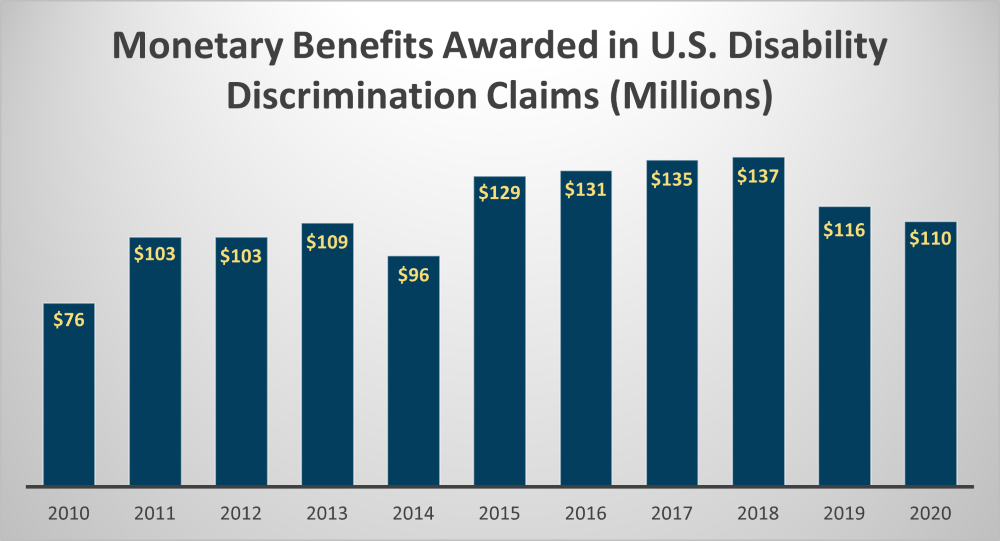Disability Discrimination Statistics [2010-2020]
Based on data from the U.S. Equal Employment Opportunity Commission, we examined national discrimination data from 2010-2021. The data includes any discrimination charges filed with the EEOC, but not charges filed with state Fair Employment Practices Agencies.
American Disabilities Act (ADA)
The ADA stands for the Americans with Disabilities Act, which was established in 1990. The ADA was inspired by the Civil Rights Act of 1964, which prohibits discrimination based on color, race, sex, religion, or nationality. Similarly, the ADA works to ensure that no one with a disability is discriminated against.
The ADA defines disability as a “physical or mental impairment that substantially limits one or more major life activities, a person who has a history or record of such an impairment, or a person who is perceived by others as having such an impairment.”
Disability Discrimination Resources
- Types of Discrimination Claims in the U.S.
- Number of Disability Discrimination Claims in the U.S.
- Types of Discrimination Claims in California
- How Are Disability Discrimination Claims Resolved?
- How Much Money is Awarded in Disability Discrimination Claims?
- Which Disabilities Receive the Most Discrimination Claims?
- How Are Disabled Employees Being Discriminated Against?
- Glossary of Terms
Discrimination Claims & Resolutions
In order to better understand disability discrimination, we will be examining all types of discrimination claims, in both the U.S. and California specifically. When a discrimination claim is filed it’s called a receipt, and it can then end in a number of different resolutions.
United States Discrimination Claims, 2020
As seen in the graph below, disability claims were the most commonly reported type of discrimination in 2020, with 24,324 claims filed. The second most common discrimination claim was for race, with 22,064.
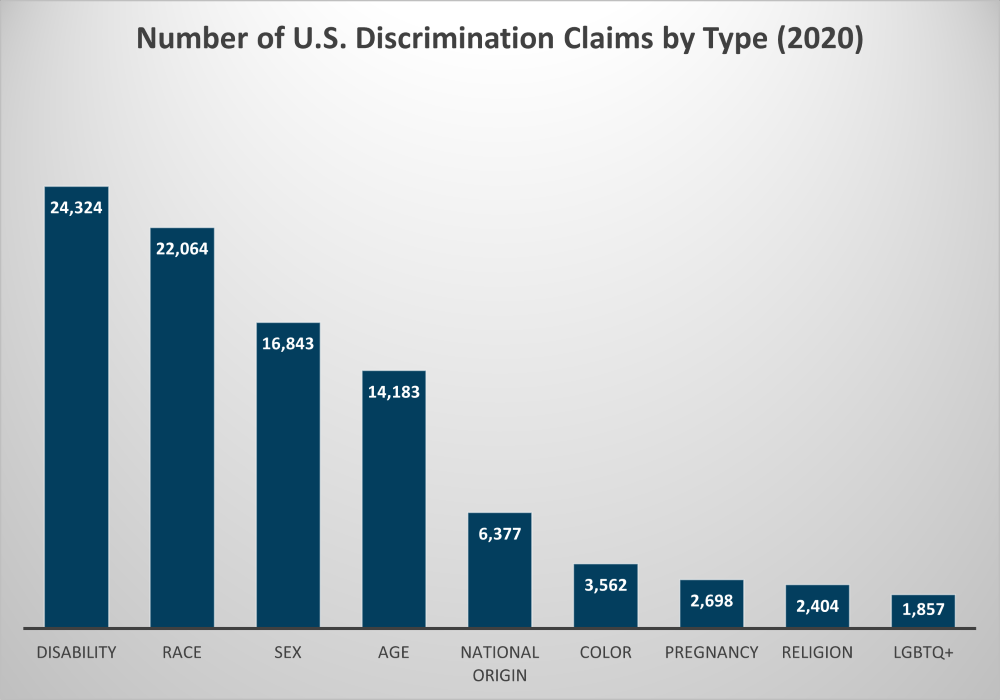
Note that sex-based discrimination claims in 2020 were reportedly higher, but because that category includes pregnancy and LGBTQ+ discrimination claims, those number were deducted for the graph above. The data also showed that age discrimination claims decreased nearly every year between 2010-2020.
United States Disability Discrimination Claims, 2010-2020
In the 10 years of 2010-2020, disability claims peaked in 2016, with 28,073 claims made to the EEOC. Barring this spike, disability discrimination claims appear to be generally decreasing over time.
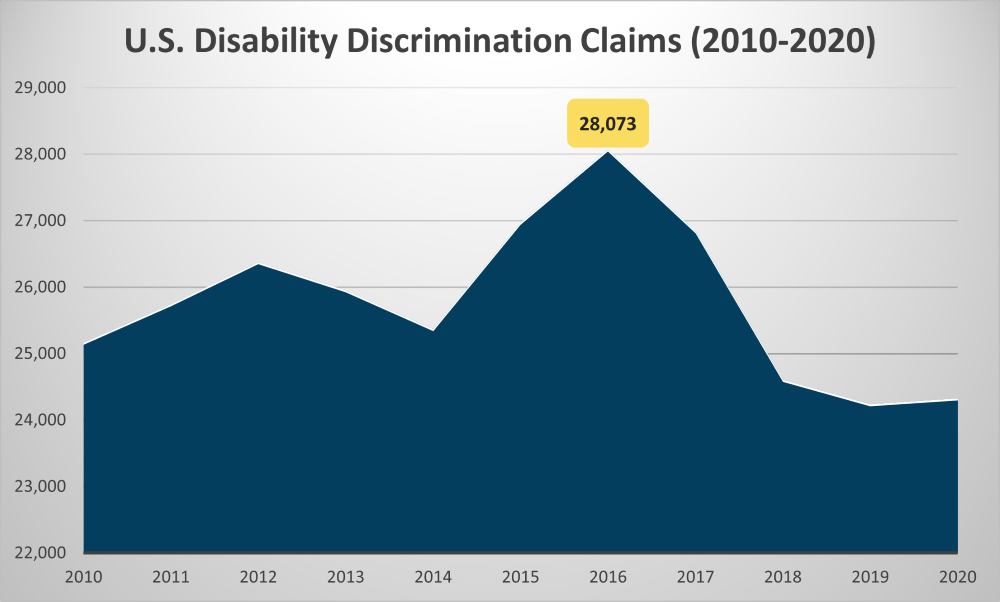
However, when it comes to disability claims that actually become lawsuits, the numbers are much smaller. In 2016, only 36 lawsuits that involved ADA claims were filed with the EEOC.
California Discrimination Claims, 2021
The most recent data from 2021 shows that in California, disability was the third highest type of discrimination claim, after retaliation.
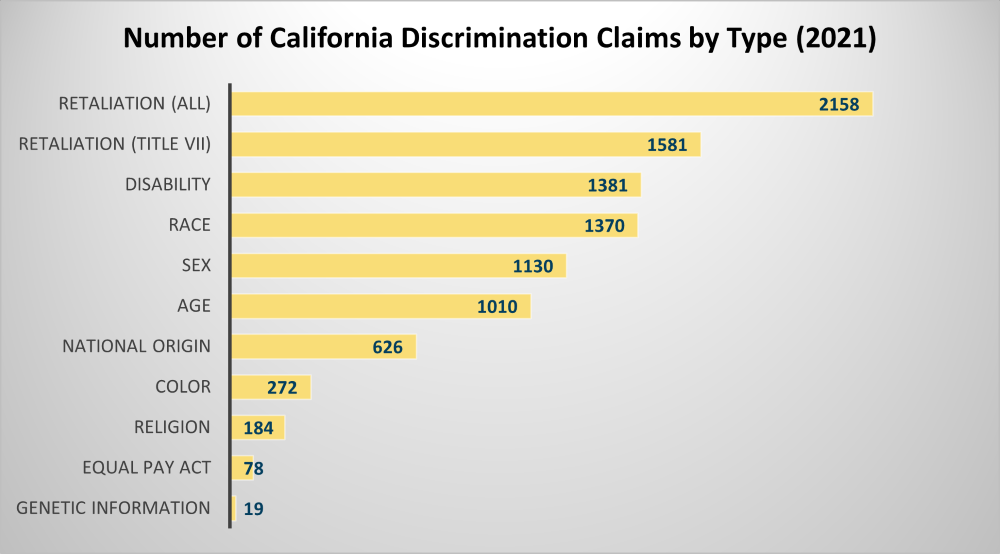
Disability discrimination claims were closely followed by race discrimination, with only 11 fewer claims. Similarly to age discrimination claims (as mentioned above), barring a spike in 2016, race discrimination claims have been decreasing since 2010.
These spikes in discrimination claims in 2016 could potentially reflect the #MeToo movement and victims’ increasing desire to speak up against harassers.
Workplace Disability Discrimination Claims
Below is a breakdown of how disability discrimination claims were resolved in 2020, as well as how many monetary benefits have been awarded over the years. To better understand each type of resolution, please refer to our glossary of important terms.
Disability Discrimination Claims by Resolution Type, 2020
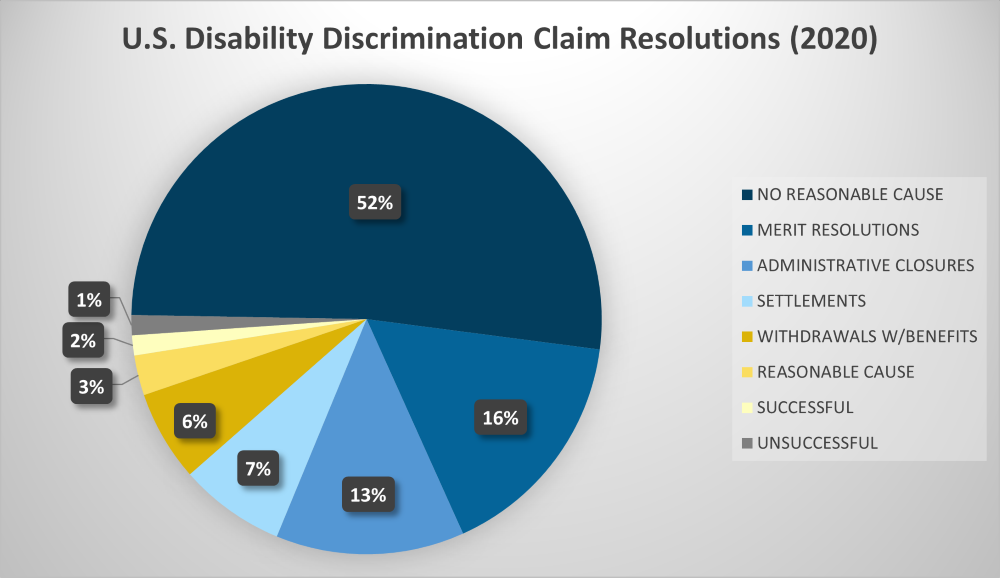
When examining the resolutions, we see that the EEOC found “no reasonable cause” in 52% of discrimination cases. The second most common resolution was finding that the discrimination claim had merit, which occurred with 16% of cases. It would be interesting to examine why so many cases were found to have no reasonable cause, however that data is not available.
Monetary Benefits in Disability Discrimination Claims (2010-2020)
Monetary benefits refer to any type of payment awarded for a successful claim. Compensatory damages is one of the remedies that is offered in response to a claim with merit. This is to cover any expenses related to the discrimination claim, such as the costs associated with a new job search, medical expenses, therapy for mental anguish, or just to cover the inconvenience and loss of enjoyment surrounding the case.
Number of Discrimination Claims Per Disability (2016-2020)
The following table breaks down the last five years of available claim data by each type of disability.
| DISABILITY | 2016 | 2017 | 2018 | 2019 | 2020 |
|---|---|---|---|---|---|
| ALCOHOLISM | 178 | 200 | 173 | 168 | 137 |
| ALLERGIES | 132 | 167 | 155 | 162 | 147 |
| ALZHEIMERS | 8 | 3 | 5 | 2 | 5 |
| ANXIETY DISORDER | 2,130 | 2,359 | 2,398 | 2,241 | 2,395 |
| ASTHMA | 380 | 390 | 358 | 350 | 362 |
| AUTISM | 91 | 133 | 133 | 148 | 176 |
| BRAIN-HEAD IMPAIRMENT | 0 | 0 | 0 | 0 | 0 |
| BRAIN-HEAD INJURY – TRAUMATIC | 303 | 302 | 302 | 323 | 313 |
| CANCER | 950 | 1,011 | 955 | 870 | 846 |
| CEREBRAL PALSY | 61 | 73 | 77 | 74 | 72 |
| CHEMICAL SENSITIVITY | 54 | 55 | 50 | 56 | 54 |
| CUMULATIVE TRAUMA DISORDER | 27 | 27 | 22 | 19 | 12 |
| CYSTIC FIBROSIS | 14 | 12 | 13 | 8 | 11 |
| DEPRESSION | 2,030 | 2,107 | 2,064 | 1,891 | 1,901 |
| DIABETES | 1,240 | 1,288 | 1,123 | 978 | 918 |
| DISFIGUREMENT | 55 | 29 | 41 | 34 | 28 |
| DRUG ADDICTION | 153 | 125 | 143 | 116 | 100 |
| DWARFISM | 6 | 14 | 9 | 7 | 6 |
| EPILEPSY | 345 | 373 | 342 | 304 | 307 |
| GASTROINTESTINAL IMPAIRMENTS | 419 | 380 | 395 | 336 | 382 |
| GENETIC DISCRIMINATION | 40 | 54 | 74 | 50 | 32 |
| GENETIC TESTING | 19 | 10 | 37 | 1 | 4 |
| HEARING IMPAIRMENT | 833 | 831 | 815 | 595 | 619 |
| HEART CARDIOVASCULAR IMPAIRMENTS | 908 | 899 | 879 | 758 | 755 |
| HIV | 198 | 234 | 247 | 174 | 139 |
| INTELLECTUAL DISABILITY | 219 | 172 | 193 | 177 | 167 |
| KIDNEY IMPAIRMENT | 231 | 236 | 222 | 201 | 197 |
| LEARNING DISABILITIES | 448 | 467 | 400 | 340 | 306 |
| MANIC DEPRESSIVE DISORDER | 853 | 822 | 787 | 661 | 605 |
| MISSING DIGITS OR LIMBS | 121 | 133 | 139 | 113 | 117 |
| MULTIPLE SCLEROSIS | 299 | 291 | 281 | 217 | 248 |
| NON-PARALYTIC ORTHOPEDIC IMPAIRMENT | 2,372 | 2,381 | 2,129 | 1,806 | 1,648 |
| ORTHOPEDIC AND STRUCTURAL IMPAIRMENTS of the BACK | 2,345 | 2,372 | 2,144 | 1,811 | 1,619 |
| OTHER BLOOD DISORDERS | 251 | 290 | 244 | 229 | 232 |
| OTHER DISABILITY | 10,727 | 11,432 | 11,038 | 10,049 | 8,979 |
| OTHER NEUROLOGICAL IMPAIRMENTS | 864 | 951 | 848 | 828 | 723 |
| OTHER PSYCHOLOGICAL DISORDERS | 482 | 468 | 477 | 402 | 380 |
| OTHER RESPIRATORY – PULMONARY DISORDERS | 285 | 312 | 318 | 230 | 245 |
| PARALYSIS | 67 | 80 | 74 | 72 | 48 |
| POST TRAUMATIC STRESS DISORDER | 1,122 | 1,205 | 1,322 | 1,345 | 1,389 |
| RECORD OF DISABILITY | 2,078 | 2,141 | 1,928 | 1,761 | 1,807 |
| REGARDED AS DISABLED | 3,143 | 3,331 | 3,133 | 2,757 | 2,465 |
| RELATIONSHIP-ASSOCIATION | 620 | 669 | 704 | 658 | 673 |
| SCHIZOPHRENIA | 98 | 132 | 134 | 100 | 83 |
| SPEECH IMPAIRMENT | 95 | 109 | 103 | 99 | 86 |
| TUBERCULOSIS | 4 | 7 | 7 | 4 | 4 |
| VISION IMPAIRMENT | 613 | 546 | 500 | 463 | 415 |
| TOTAL | 29,575 | 30,946 | 29,511 | 26,270 | 24,546 |
Disabilities with the Most Discrimination Claims, 2020
Looking more closely at the data above, we see that the disabilities with the most discrimination claims are as follows.
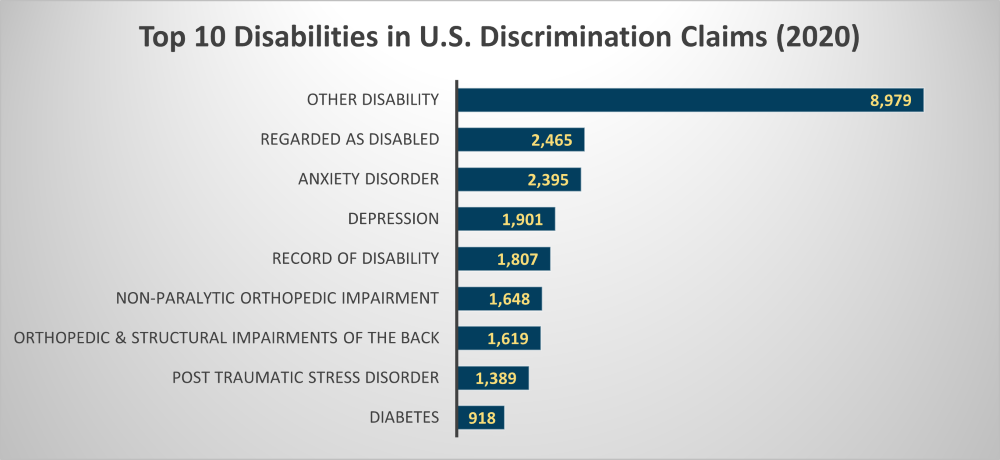
Unfortunately the highest disability category, “other disability,” is not broken down any further. The second most common disability in discrimination claims is “regarded as disabled.” The EEOC defines this term as someone who is “subject to an action prohibited by the ADA based on an impairment that is not transitory and minor.” If someone is only covered under this category of disability, they do not qualify for reasonable accommodation.
ADA Claims by Discrimination Type, 2016-2020
| ISSUE | 2016 | 2017 | 2018 | 2019 | 2020 |
|---|---|---|---|---|---|
| Advertising | 5 | 0 | 1 | 3 | 2 |
| Apprenticeship | 3 | 0 | 8 | 5 | 8 |
| Assignment | 1,015 | 870 | 952 | 1,009 | 964 |
| Benefits | 308 | 310 | 246 | 330 | 296 |
| Benefits-Insurance | 207 | 200 | 194 | 217 | 162 |
| Benefits-Retirement/Pension | 45 | 44 | 38 | 47 | 31 |
| Breach of Confidentiality | 285 | 223 | 242 | 234 | 210 |
| Constructive Discharge | 1,403 | 1,388 | 1,502 | 1,732 | 1,744 |
| Demotion | 676 | 645 | 603 | 627 | 610 |
| Discharge | 16,455 | 15,842 | 14,860 | 14,592 | 15,193 |
| Discipline | 3,249 | 3,112 | 2,997 | 2,910 | 2,765 |
| Early Retirement Incentive | 5 | 8 | 6 | 8 | 4 |
| English Language Only Rule | 0 | 0 | 0 | 0 | 0 |
| Exclusion | 117 | 153 | 119 | 163 | 166 |
| Filing EEO Forms | 0 | 0 | 0 | 0 | 3 |
| ALL Harassment * | 5,410 | 5,277 | 5,014 | 5,073 | 5,138 |
| Harassment** | 5,410 | 5,277 | 5,014 | 5,073 | 5,138 |
| Hiring | 1,456 | 1,403 | 1,291 | 1,275 | 1,171 |
| Intimidation | 571 | 519 | 497 | 507 | 500 |
| Job Classification | 65 | 62 | 51 | 56 | 39 |
| Layoff | 353 | 302 | 290 | 282 | 419 |
| Maternity | 45 | 45 | 54 | 47 | 42 |
| Other | 593 | 572 | 505 | 545 | 589 |
| Other Language/Accent Issue | 0 | 0 | 0 | 0 | 0 |
| Paternity | 0 | 0 | 0 | 0 | 0 |
| Posting Notices | 3 | 4 | 1 | 2 | 2 |
| Prohibited Medical Inquiry/Exam | 282 | 225 | 215 | 206 | 430 |
| Promotion | 759 | 751 | 664 | 686 | 709 |
| Qualifications | 23 | 28 | 16 | 36 | 26 |
| Reasonable Accommodation | 11,865 | 11,754 | 11,754 | 11,120 | 11,469 |
| Recall | 26 | 21 | 20 | 15 | 35 |
| Recordkeeping Violation | 56 | 23 | 20 | 15 | 10 |
| References Unfavorable | 78 | 75 | 70 | 72 | 71 |
| Referral | 22 | 11 | 11 | 10 | 8 |
| Reinstatement | 213 | 146 | 158 | 155 | 228 |
| Retirement-Involuntary | 40 | 52 | 53 | 69 | 50 |
| Segregated Facilities | 4 | 2 | 4 | 3 | 3 |
| Segregated Locals | 1 | 0 | 0 | 2 | 0 |
| Seniority | 27 | 20 | 14 | 32 | 13 |
| Severance Pay Denied | 10 | 8 | 13 | 19 | 17 |
| Sexual Harassment*** | 0 | 0 | 0 | 0 | 2 |
| Suspension | 1,030 | 945 | 823 | 851 | 749 |
| Tenure | 13 | 16 | 23 | 26 | 19 |
| Terms/Conditions | 5,827 | 5,597 | 5,058 | 4,898 | 4,960 |
| Testing | 40 | 35 | 55 | 43 | 39 |
| Training | 205 | 190 | 185 | 181 | 214 |
| Union Representation | 70 | 66 | 55 | 64 | 55 |
| Wages | 772 | 701 | 699 | 740 | 719 |
| Waivers | 16 | 10 | 11 | 7 | 7 |
*Includes charges where harassment is alleged.
**Does not include sexual harassment charges unless both harassment and sexual harassment are alleged concurrently, meaning alleged in a single charge.
***Does not include harassment charges unless both harassment and sexual harassment are alleged concurrently, meaning alleged in a single charge.
Disability Discrimination Laws
Lawyers who specialize in employee rights are often called upon to assist in discrimination claims. If someone is qualified to do their job yet is still experiencing workplace discrimination due to a disability, the employer is acting illegally. Employers are required to provide “reasonable accommodation” to any employee who needs it to perform their job, such as modifying work schedules, providing alternative equipment, or providing an interpreter.
Not only is disability discrimination federally illegal, but also under California state law. The Department of Fair Employment and Housing (DFEH) prohibits discrimination against disabled California employees in companies with at least five employees. Other states have similar laws in place. If you believe you have been discriminated against at work for your disability, you should file a claim with the EEOC.
Important Terms
These terms are used by the EEOC in defining discrimination claims and their resolutions.
- Receipts: Charges filed with the EEOC. A charge may include multiple issues.
- Resolutions: Charges that have been closed. This includes a number of resolution types (see below).
Resolution Types
- Administrative Closure: Charges closed for administrative reasons, such as a claim being filed too late or the employer not having enough employees to be held responsible under federal law.
- Merit Resolutions: Charges resolved with an outcome favorable to the charging party (the person filing the claim). These include the following resolutions:
- Negotiated Settlements: Charges are settled during the investigation with benefits to the charging party.
- No Reasonable Cause: EEOC’s decision not to proceed further with the investigation. In issuing this decision, the EEOC makes no resolution about the merits of claims alleged in the charge. The charging party may still file a claim in private court.
- Reasonable Cause: EEOC’s decision, based upon the evidence, that it believes discrimination did occur. Reasonable cause decisions are followed by efforts to resolve the discriminatory issues.
- Successful Conciliation: Charge with a reasonable cause decision is closed after resolution of the charge through voluntary efforts.
- Unsuccessful Conciliation: Charge with a reasonable cause decision is closed after failure to resolve the charge through voluntary efforts.
- Withdrawal with Benefits: Charge is withdrawn, at the request of the charging party, who will receive benefits through a separate agreement with their employer.
- Monetary Benefits — Administrative Enforcement: Various types of relief secured through administrative enforcement in the resolution of a charge of discrimination that have a financial valuation. This includes restored pay, compensatory damages, punitive and liquidated damages, attorney’s fees, fringe benefits, and training or tuition costs. It may also include the costs of hiring, reinstatement, recall or other actions that result in employment for the charging party, as well as promotions and prospective fringe benefits.

